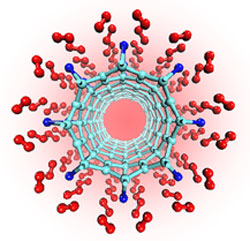May 5, 2005

[NIST
Tech Beat Search] [Credits] [NIST Tech Beat
Archives] [Media
Contacts] [Subscription Information]

'Metal-Decorated'
Nanotubes Hold Promise for Fuel Cells
 |
| This
computer model shows how titanium atoms (dark blue) can
attach above the centers of single-walled carbon nanotubes
(light blue). Quantum calculations and modeling by a NIST
researcher and his colleague reveal that each titanium
atom can bond with four hydrogen molecules (red), a finding
that could lead to efficient fuel cells for future automobiles.
Image
Credit: T. Yildirim/NIST
|
New
quantum calculations and computer models show that carbon nanotubes
“decorated” with titanium or other transition metals
can latch on to hydrogen molecules in numbers more than adequate
for efficient hydrogen storage, a capability key to long-term
efforts to develop fuel cells, an affordable non-polluting alternative
to gasoline.
National
Institute of Standards and Technology theorist Taner Yildirim
and physicist Salim Ciraci of Turkey’s Bilkent University
report their “unanticipated” findings in the online
issue of Physical Review Letters.*
Using established
quantum physics theory, they predict that hydrogen can amass
in amounts equivalent to 8 percent of the weight of “titanium-decorated”
singled walled carbon nanotubes. That’s one-third better
than the 6 percent minimum storage-capacity requirement set
by the FreedomCar Research Partnership involving the Department
of Energy and the nation’s “Big 3” automakers.
As important,
the four hydrogen molecules (two atoms each) that link to a
titanium atom are readily relinquished when heated. Such reversible
desorption is another requirement for practical hydrogen storage.
Resembling
exceedingly small cylinders of chicken wire, so-called single-walled
carbon nanotubes are among several candidate materials eyed
for hydrogen storage. Reaching the 6 percent target, however,
has proved difficult—a potential “showstopper,”
according to many in the field. Positioning a titanium atom
above the center of hexagonally arranged carbon atoms (the repeating
geometric pattern characteristic of carbon nanotubes) appears
to resolve the impasse according to this new study.
The new
results, obtained with a method for calculating the electronic
structure of materials, surprised the researchers. Interactions
among carbon, titanium and hydrogen seem to give rise to unusual
attractive forces. The upshot is that four hydrogen molecules
can dock on a titanium atom, apparently by means of a unique
chemical bond of modest strength. Several forces at work within
the geometric arrangement appear to play a role in the reversible
tethering of hydrogen, Yildirim says.
Yildirim
and Ciraci report that their findings “suggest a possible
method of engineering new nanostructures for high-capacity storage
and catalyst materials.” The work was funded, in part,
by the Department of Energy and National Science Foundation.
*T. Yildirim
and S. Ciraci. Titanium-Decorated Carbon Nanotubes as a Potential
High-Capacity Hydrogen Storage Medium. Phys. Rev. Lett.
94, 175501 (2005).
More information,
such as animation of the reaction paths and other simulations,
can be obtained at www.ncnr.nist.gov/staff/taner/h2.

Study
Examines Measurement of Service Sector R&D
The
services sector in the United States—which includes
everything from restaurants to telecommunications to banking—is
a major driving force of the economy, generating about 80
percent of the U.S. gross domestic product. As a result, tracking
innovation in the services sector is an important indicator
of future economic health.
But a
new
joint research project of the National Institute of Standards
and Technology (NIST) and the National Science Foundation
(NSF) found that it has become progressively more difficult
to classify the research and development (R&D) that fuels
innovation in the services sector. "The distinction between
the manufacturing and service sectors is becoming increasingly
blurred," producing important impacts on the reporting
of R&D activities, write Michael Gallaher and co-authors
from RTI International of Research Triangle Park, N.C.
In some
cases, data collected for NSF's annual Survey of Industry
Research and Development are classified as services R&D
because the parent company is part of the service economy,
yet the R&D described is directed at new manufactured
products. In other cases, manufacturing companies are increasingly
providing services and conducting service-related R&D
that ends up being classified as manufacturing R&D. To
improve the accuracy of the survey, the study makes a number
of recommendations for improved definitions and revised wording
of questions.
The study
included detailed case studies from telecommunications, financial,
system integration, and research, development and testing
services. R&D in telecommunications, for example, might
include the work required to deliver videos and other multimedia
to wireless phones. In emerging areas such as biotechnology,
small firms increasingly use contract research organizations
(CROs) to provide complementary research services.
NIST
plans to use the study results for strategic planning to identify
infrastructure improvements that will help foster innovation
in the technology services sector.
*M. Gallaher,
A.Link, J. Petrusa, RTI International. Measuring Service-Sector
Research and Development, March 2005. Available at http://www.nist.gov/director/prog-ofc/report05-1.pdf

DVD
Showcases 2004 Baldrige Award Winners
A
new set of videos on DVD and
CD can help companies large and small, schools and health care
organizations learn about the outstanding management practices
and successful strategies of the four recipients of the 2004
Malcolm Baldrige National Quality Award.
The DVD/CD
set contains an in-depth look at The Bama Companies, Texas Nameplate
Company, Inc., Kenneth W. Monfort College of Business, and Robert
Wood Johnson University Hospital Hamilton and features extensive
interviews with their chief executives. Also included are PowerPoint
presentations by the 2004 award recipients at The Quest for
Excellence conference held April 10-13, 2005, and summaries
of their applications for the Baldrige Award.
The set
is available from the American Society for Quality, P.O. Box
3066, Milwaukee, Wis. 53201-3066, (800) 248-1946 for $35.00.
Use order number T1504. Other Baldrige National Quality Program
materials also are available.
The Baldrige
Award recognizes organizations in manufacturing, small business,
service, education, and health care for their performance excellence
and quality achievements. The award is managed by the National
Institute of Standards and Technology in conjunction with the
private sector.
For more
information, see http://baldrige.nist.gov.
Media
Contact:
Jan
Kosko, janice.kosko@nist.gov,
(301) 975-2767


NIST
Fire Analysis Tools Featured in Online Training
A
free
interactive online training program for fire fighters
and arson investigators that features fire research, video
footage and expert analysis from the National Institute
of Standards and Technology (NIST) is now available. Launched
by the International Association of Arson Investigators
(IAAI), the program is the first Internet-based course
on www.cfitrainer.net,
a new educational network.
The
course, "Fire Dynamics and Fire Modeling," provides
a review of tools an investigator can employ to develop
a technical analysis of a fire incident. Daniel Madrzykowski,
NIST fire protection engineer and lead researcher in many
of the experimental fire tests, helped develop the course
and narrates many of its segments.
Course
participants can observe fire investigation techniques
such as physical testing, hand calculations and zone models,
as well as “virtual reality” reconstructions
of fire incidents with the NIST Fire Dynamics Simulator
(FDS) and Smokeview software programs. (FDS calculates
the movement of the smoke and heat from a fire. Smokeview
translates the calculations into moving images on the
computer screen.)
Several
case studies based on actual fire incidents also are used
to demonstrate the capabilities and limitations of fire
modeling. The program describes data that must be collected
at the fire site to improve computer simulation results,
an overview of the uncertainties in the models, and methods
for evaluating model results.
A
“readings” section, with contributions from
leading trade, professional, government and private research
organizations, offers additional information. NIST selections,
for instance, offer access to FIREDOC, the search engine
for the NIST Fire Research Information Services library,
research on liquid spill and burn patterns, as well as
downloads of the Fire Dynamics Simulator and Smokeview
software.
In
addition to the IAAI, research partners depicted in the
course include the U.S. Fire Administration (USFA), the
Bureau of Alcohol, Tobacco, Firearms and Explosives (ATF),
the National Institute of Justice (NIJ), the National
Center for Forensic Sciences (NCFS), and the National
Institute for Occupational Safety and Healt (NIOSH).
Media
Contact:
John
Blair, john.blair@nist.gov,
(301) 975-4261

Quick
Links
 |
| Deborah
S. Jin
©
Geoffrey Wheeler
For
a high resolution version of this photo,
contact Gail
Porter.
|
Jin
Elected to National Academy of Sciences
Deborah
S. Jin, a fellow of JILA, which is jointly operated
by the National Institute of Standards and Technology
(NIST) and the University of Colorado (CU) Boulder,
has been elected as one of 72 new members to
the National Academy of Sciences (NAS). Jin,
a NIST fellow, is also an associate adjoint
professor at CU-Boulder.
Jin,
36, is the youngest woman, along with Susan
Solomon of the National Oceanic and Atmospheric
Administration, to be elected to the academy.
Election
to membership in the academy is considered one
of the highest honors that can be accorded a
U.S. scientist or engineer. Members are elected
by current members in recognition of their distinguished
and continuing achievements in original research.
The NAS election was held May 3, 2005, during
the business session of the 142nd annual meeting
of the academy. The current total number of
active members is 1,976. (For a link to the
press release with the full list of new members,
see http://national-academies.org/.)
Jin
leads a team of physicists at JILA that reported
in January 2004 the first observation of
a “fermionic condensate” formed
from pairs of atoms in an ultracold gas, a long-sought,
novel form of matter. Physicists hope that further
research with such condensates eventually will
help unlock the mysteries of high-temperature
superconductivity, a phenomenon with the potential
to improve energy efficiency dramatically across
a broad range of applications.
In
October 2003, Jin won a $500,000 MacArthur
Fellowship, commonly known as a "genius
grant."


NIST
Requests Comments on Managing Cryptographic
Keys
The
strongest safe cannot protect the contents within
if the combination is poorly protected. The
same is true of information protected by cryptography—proper
management and protection of the keys needed
to unlock cryptographic algorithms are essential.
NIST
is asking for public comments on a draft publication,
Recommendation for Key Management (NIST
Special Publication 800-57) that will provide
guidance on managing cryptographic keys. The
publication is in two parts: Part 1 provides
general guidance and best practices for managing
cryptographic keying material (comments are
due by June 3); Part 2 provides guidance on
policy and security planning requirements for
U.S. government agencies (comments are due by
May 18). The report is available at http://csrc.nist.gov/publications/drafts.html.
Comments should be sent to Key_mgmt@nist.gov.
|

